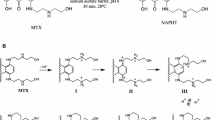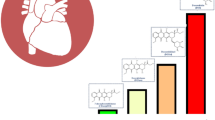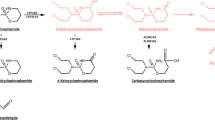Abstract
Mitoxantrone (MTX) is an antineoplastic agent used to treat advanced breast cancer, prostate cancer, acute leukemia, lymphoma and multiple sclerosis. Although it is known to cause cumulative dose-related cardiotoxicity, the underlying mechanisms are still poorly understood. This study aims to compare the cardiotoxicity of MTX and its’ pharmacologically active metabolite naphthoquinoxaline (NAPHT) in an in vitro cardiac model, human-differentiated AC16 cells, and determine the role of metabolism in the cardiotoxic effects. Concentration-dependent cytotoxicity was observed after MTX exposure, affecting mitochondrial function and lysosome uptake. On the other hand, the metabolite NAPHT only caused concentration-dependent cytotoxicity in the MTT reduction assay. When assessing the effect of different inhibitors/inducers of metabolism, it was observed that metyrapone (a cytochrome P450 inhibitor) and phenobarbital (a cytochrome P450 inducer) slightly increased MTX cytotoxicity, while 1-aminobenzotriazole (a suicide cytochrome P450 inhibitor) decreased fairly the MTX-triggered cytotoxicity in differentiated AC16 cells. When focusing in autophagy, the mTOR inhibitor rapamycin and the autophagy inhibitor 3-methyladenine exacerbated the cytotoxicity caused by MTX and NAPHT, while the autophagy blocker, chloroquine, partially reduced the cytotoxicity of MTX. In addition, we observed a decrease in p62, beclin-1, and ATG5 levels and an increase in LC3-II levels in MTX-incubated cells. In conclusion, in our in vitro model, neither metabolism nor exogenously given NAPHT are major contributors to MTX toxicity as seen by the residual influence of metabolism modulators used on the observed cytotoxicity and by NAPHT’s low cytotoxicity profile. Conversely, autophagy is involved in MTX-induced cytotoxicity and MTX seems to act as an autophagy inducer, possibly through p62/LC3-II involvement.
Graphical abstract









Similar content being viewed by others
Abbreviations
- 1-ABT:
-
1-Aminobenzotriazole
- 3- MA:
-
3-Methyladenine
- ATG5:
-
Autophagy related 5
- CQ:
-
Chloroquine
- DAS:
-
Diallyl sulfide
- DMEM/F-12:
-
Dulbecco´s modified Eagle´s medium/nutrient F-12 Ham
- DMSO:
-
Dimethyl sulfoxide
- GAPDH:
-
Glyceraldehyde-3-phosphate dehydrogenase
- LC3:
-
Microtubule-associated protein 1A/1B-light chain 3
- MTT:
-
4,5-Dimethylthiazol-2-yl)-2,5-diphenyl tetrazolium bromide
- MTP:
-
Metyrapone
- MTX:
-
Mitoxantrone
- NAPHT:
-
Naphthoquinoxaline
- NR:
-
Neutral red
- OD:
-
Optic density
- PHB:
-
Phenobarbital
- PI3K-III:
-
Class III phosphatidylinositol 3-kinase
- RAP:
-
Rapamycin
- RIF:
-
Rifampicin (RIF)
- SD:
-
Standard deviation
References
Aguirre-Hernández C, Maya-Pineda H, Millán JS, Man YKS, Lu Y-J, Halldén G (2018) Sensitisation to mitoxantrone-induced apoptosis by the oncolytic adenovirus Ad∆∆ through Bcl-2-dependent attenuation of autophagy. Oncogenesis 7(1):6
Alberts DS, Peng YM, Leigh S, Davis TP, Woodward DL (1985) Disposition of mitoxantrone in cancer patients. Cancer Res 45(4):1879–1884
An G, Morris ME (2010) HPLC analysis of mitoxantrone in mouse plasma and tissues: application in a pharmacokinetic study. J Pharm Biomed Anal 51(3):750–753
Baek KH, Park J, Shin I (2012) Autophagy-regulating small molecules and their therapeutic applications. Chem Soc Rev 41(8):3245–3263
Bains OS, Grigliatti TA, Reid RE, Riggs KW (2010) Naturally occurring variants of human aldo-keto reductases with reduced in vitro metabolism of daunorubicin and doxorubicin. J Pharmacol Exp Ther 335(3):533–545
Behnia K, Boroujerdi M (1999) Inhibition of aldo-keto reductases by phenobarbital alters metabolism, pharmacokinetics and toxicity of doxorubicin in rats. J Pharm Pharmacol 51(11):1275–1282
Bik E, Mateuszuk L, Orleanska J, Baranska M, Chlopicki S, Majzner K (2021) Chloroquine-induced accumulation of autophagosomes and lipids in the endothelium. Int J Mol Sci 22:5
Bjørkøy G, Lamark T, Pankiv S, Øvervatn A, Brech A, Johansen T (2009) Monitoring autophagic degradation of p62/SQSTM1. Methods Enzymol 452:181–197
Blanz J, Mewes K, Ehninger G et al (1991a) Isolation and structure elucidation of urinary metabolites of mitoxantrone. Cancer Res 51(13):3427–3433
Blanz J, Mewes K, Ehninger G et al (1991b) Evidence for oxidative activation of mitoxantrone in human, pig, and rat. Drug Metab Dispos 19(5):871–880
Blättler SM, Rencurel F, Kaufmann MR, Meyer UA (2007) In the regulation of cytochrome P450 genes, phenobarbital targets LKB1 for necessary activation of AMP-activated protein kinase. Proc Natl Acad Sci U S A 104(3):1045–1050
Brück TB, Brück DW (2011) Oxidative metabolism of the anti-cancer agent mitoxantrone by horseradish, lacto-and lignin peroxidase. Biochimie 93(2):217–226
Bulutoglu B, Mert S, Rey-Bedón C, Deng SL, Yarmush ML, Usta OB (2019) Rapid maturation of the hepatic cell line Huh7 via CDK inhibition for PXR dependent CYP450 metabolism and induction. Sci Rep 9(1):15848
Chen ML, Yi L, Jin X et al (2013) Resveratrol attenuates vascular endothelial inflammation by inducing autophagy through the cAMP signaling pathway. Autophagy 9(12):2033–2045
Chiccarelli FS, Morrison JA, Cosulich DB et al (1986) Identification of human urinary mitoxantrone metabolites. Cancer Res 46(9):4858–4861
Costa VM, Carvalho F, Duarte JA, Bastos ML, Remião F (2013) The heart as a target for xenobiotic toxicity: the cardiac susceptibility to oxidative stress. Chem Res Toxicol 26(9):1285–1311
Costa VM, Capela JP, Sousa JR et al (2020) Mitoxantrone impairs proteasome activity and prompts early energetic and proteomic changes in HL-1 cardiomyocytes at clinically relevant concentrations. Arch Toxicol 94(12):4067–4084
Cuervo AM (2004) Autophagy: many paths to the same end. Mol Cell Biochem 263(1–2):55–72
Davidson MM, Nesti C, Palenzuela L et al (2005) Novel cell lines derived from adult human ventricular cardiomyocytes. J Mol Cell Cardiol 39(1):133–147
De Meyer GR, Martinet W (2009) Autophagy in the cardiovascular system. Biochim Biophys Acta 1793(9):1485–1495
de Montellano PRO (2018) 1-Aminobenzotriazole: a mechanism-based cytochrome P450 inhibitor and probe of cytochrome P450 biology. Med Chem 8:3
Deng Y, Wang L, Yang Y et al (2013) In vitro inhibition and induction of human liver cytochrome P450 enzymes by gentiopicroside: potent effect on CYP2A6. Drug Metab Pharmacokinet 28(4):339–344
Dionísio F, Araújo AM, Duarte-Araújo M et al (2022) Cardiotoxicity of cyclophosphamide’s metabolites: an in vitro metabolomics approach in AC16 human cardiomyocytes. Arch Toxicol 96(2):653–671
Dores-Sousa JL, Duarte JA, Seabra V, Bastos ML, Carvalho F, Costa VM (2015) The age factor for mitoxantrone’s cardiotoxicity: multiple doses render the adult mouse heart more susceptible to injury. Toxicology 329:106–119
Duthie SJ, Grant MH (1989) The role of reductive and oxidative metabolism in the toxicity of mitoxantrone, adriamycin and menadione in human liver derived Hep G2 hepatoma cells. Br J Cancer 60(4):566–571
Ehninger G, Schuler U, Proksch B, Zeller KP, Blanz J (1990) Pharmacokinetics and metabolism of mitoxantrone A Review. Clin Pharmacokinet 18(5):365–380
Evison BJ, Sleebs BE, Watson KG, Phillips DR, Cutts SM (2016) Mitoxantrone, more than just another topoisomerase II poison. Med Res Rev 36(2):248–299
Feofanov A, Sharonov S, Fleury F, Kudelina I, Nabiev I (1997a) Quantitative confocal spectral imaging analysis of mitoxantrone within living K562 cells: intracellular accumulation and distribution of monomers, aggregates, naphtoquinoxaline metabolite, and drug-target complexes. Biophys J 73(6):3328–3336
Feofanov A, Sharonov S, Kudelina I, Fleury F, Nabiev I (1997b) Localization and molecular interactions of mitoxantrone within living K562 cells as probed by confocal spectral imaging analysis. Biophys J 73(6):3317–3327
Fox EJ (2004) Mechanism of action of mitoxantrone. Neurology 63(12 Suppl 6):S15–S18
Galluzzi L, Baehrecke EH, Ballabio A et al (2017) Molecular definitions of autophagy and related processes. Embo j 36(13):1811–1836
Guan F, Yang X, Li J et al (2019) New molecular mechanism underlying myc-mediated cytochrome P450 2E1 upregulation in apoptosis and energy metabolism in the myocardium. J Am Heart Assoc 8(1):e009871
Guan Y, Jiang S, Ye W et al (2020) Combined treatment of mitoxantrone sensitizes breast cancer cells to rapalogs through blocking eEF-2K-mediated activation of Akt and autophagy. Cell Death Dis 11(11):948
Handschin C, Meyer UA (2003) Induction of drug metabolism: the role of nuclear receptors. Pharmacol Rev 55(4):649–673
Hariharan N, Zhai P, Sadoshima J (2011) Oxidative stress stimulates autophagic flux during ischemia/reperfusion. Antioxid Redox Signal 14(11):2179–2190
Ikeda S, Zablocki D, Sadoshima J (2022) The role of autophagy in death of cardiomyocytes. J Mol Cell Cardiol 165:1–8
Jin M, Ande A, Kumar A, Kumar S (2013) Regulation of cytochrome P450 2e1 expression by ethanol: role of oxidative stress-mediated pkc/jnk/sp1 pathway. Cell Death Dis 4(3):e554
Kassner N, Huse K, Martin HJ et al (2008) Carbonyl reductase 1 is a predominant doxorubicin reductase in the human liver. Drug Metab Dispos 36(10):2113–2120
Kawalek JC, Gilbertson JR (1976) Partial purification of the NADPH-dependent aldehyde reductase from bovine cardiac muscle. Arch Biochem Biophys 173(2):649–657
Kluza J, Marchetti P, Gallego MA et al (2004) Mitochondrial proliferation during apoptosis induced by anticancer agents: effects of doxorubicin and mitoxantrone on cancer and cardiac cells. Oncogene 23(42):7018–7030
Kolodziejczyk P, Reszka K, Lown JW (1988) Enzymatic oxidative activation and transformation of the antitumor agent mitoxantrone. Free Radic Biol Med 5(1):13–25
Kostin S, Pool L, Elsässer A et al (2003) Myocytes die by multiple mechanisms in failing human hearts. Circ Res 92(7):715–724
Li SJ, Rodgers EH, Grant MH (1995) The activity of xenobiotic enzymes and the cytotoxicity of mitoxantrone in MCF 7 human breast cancer cells treated with inducing agents. Chem Biol Interact 97(2):101–118
Liao YX, Yu HY, Lv JY et al (2019) Targeting autophagy is a promising therapeutic strategy to overcome chemoresistance and reduce metastasis in osteosarcoma. Int J Oncol 55(6):1213–1222
Lin JH (2006) CYP induction-mediated drug interactions: in vitro assessment and clinical implications. Pharm Res 23(6):1089–1116
Linder CD, Renaud NA, Hutzler JM (2009) Is 1-aminobenzotriazole an appropriate in vitro tool as a nonspecific cytochrome P450 inactivator? Drug Metab Dispos 37(1):10–13
Liu WJ, Ye L, Huang WF et al (2016) p62 links the autophagy pathway and the ubiqutin-proteasome system upon ubiquitinated protein degradation. Cell Mol Biol Lett 21:29
Ljubojević-Holzer S, Kraler S, Djalinac N et al (2021) Loss of autophagy protein ATG5 impairs cardiac capacity in mice and humans through diminishing mitochondrial abundance and disrupting Ca2+ cycling. Cardiovasc Res 118(6):1492–1505
Mauthe M, Orhon I, Rocchi C et al (2018) Chloroquine inhibits autophagic flux by decreasing autophagosome-lysosome fusion. Autophagy 14(8):1435–1455
McGahon AJ et al (1995) The end of the (cell) line: methods for the study of apoptosis in vitro. In: Schwartz LW, Osborne BA (eds) methods in cell biology, vol 46. Academic Press, New York, pp 153–185
Menna P, Minotti G, Salvatorelli E (2007) In vitro modeling of the structure-activity determinants of anthracycline cardiotoxicity. Cell Biol Toxicol 23(1):49–62
Menon MB, Dhamija S (2018) Beclin 1 phosphorylation—at the center of autophagy regulation. Front Cell Dev Biol 6:137
Mewes K, Blanz J, Ehninger G, Gebhardt R, Zeller KP (1993) Cytochrome P-450-induced cytotoxicity of mitoxantrone by formation of electrophilic intermediates. Cancer Res 53(21):5135–5142
Michaud V, Frappier M, Dumas MC, Turgeon J (2010) Metabolic activity and mRNA levels of human cardiac CYP450s involved in drug metabolism. PLoS ONE 5(12):e15666
Mizushima N (2007) Autophagy: process and function. Genes Dev 21(22):2861–2873
Nakai A, Yamaguchi O, Takeda T et al (2007) The role of autophagy in cardiomyocytes in the basal state and in response to hemodynamic stress. Nat Med 13(5):619–624
Panousis C, Kettle AJ, Phillips DR (1994) Oxidative metabolism of mitoxantrone by the human neutrophil enzyme myeloperoxidase. Biochem Pharmacol 48(12):2223–2230
Panousis C, Kettle AJ, Phillips DR (1997) Neutrophil-mediated activation of mitoxantrone to metabolites which form adducts with DNA. Cancer Lett 113(1–2):173–178
Parzych KR, Klionsky DJ (2014) An overview of autophagy: morphology, mechanism, and regulation. Antioxid Redox Signal 20(3):460–473
Reis-Mendes AF, Sousa E, de Lourdes BM, Costa VM (2015) The role of the metabolism of anticancer drugs in their induced-cardiotoxicity. Curr Drug Metab 17(1):75–90
Reis-Mendes A, Gomes AS, Carvalho RA et al (2017) Naphthoquinoxaline metabolite of mitoxantrone is less cardiotoxic than the parent compound and it can be a more cardiosafe drug in anticancer therapy. Arch Toxicol 91(4):1871–1890
Reis-Mendes A, Dores-Sousa JL, Padrão AI et al (2021) Inflammation as a possible trigger for mitoxantrone-induced cardiotoxicity: an in vivo study in adult and infant mice. Pharmaceuticals 14:6
Repetto G, del Peso A, Zurita JL (2008) Neutral red uptake assay for the estimation of cell viability/cytotoxicity. Nat Protoc 3(7):1125–1131
Richard B, Fabre G, De Sousa G, Fabre I, Rahmani R, Cano JP (1991) Interspecies variability in mitoxantrone metabolism using primary cultures of hepatocytes isolated from rat, rabbit and humans. Biochem Pharmacol 41(2):255–262
Rossato LG, Costa VM, de Pinho PG et al (2013a) The metabolic profile of mitoxantrone and its relation with mitoxantrone-induced cardiotoxicity. Arch Toxicol 87(10):1809–1820
Rossato LG, Costa VM, Vilas-Boas V et al (2013b) Therapeutic concentrations of mitoxantrone elicit energetic imbalance in H9c2 cells as an earlier event. Cardiovasc Toxicol 13(4):413–425
Sampath-Kumar R, Yu M, Khalil MW, Yang K (1997) Metyrapone is a competitive inhibitor of 11beta-hydroxysteroid dehydrogenase type 1 reductase. J Steroid Biochem Mol Biol 62(2–3):195–199
Sarkar S, Ravikumar B, Floto RA, Rubinsztein DC (2009) Rapamycin and mTOR-independent autophagy inducers ameliorate toxicity of polyglutamine-expanded huntingtin and related proteinopathies. Cell Death Differ 16(1):46–56
Scott LJ, Figgitt DP (2004) Mitoxantrone: a review of its use in multiple sclerosis. CNS Drugs 18(6):379–396
Shipp NG, Dorr RT, Alberts DS, Dawson BV, Hendrix M (1993) Characterization of experimental mitoxantrone cardiotoxicity and its partial inhibition by ICRF-187 in cultured neonatal rat heart cells. Cancer Res 53(3):550–556
Soares AS, Costa VM, Diniz C, Fresco P (2014) Combination of Cl-IB-MECA with paclitaxel is a highly effective cytotoxic therapy causing mTOR-dependent autophagy and mitotic catastrophe on human melanoma cells. J Cancer Res Clin Oncol 140(6):921–935
Su H, Wang X (2011) p62 Stages an interplay between the ubiquitin-proteasome system and autophagy in the heart of defense against proteotoxic stress. Trends Cardiovasc Med 21(8):224–228
Sun Q, Harper TW, Dierks EA et al (2011) 1-Aminobenzotriazole, a known cytochrome P450 inhibitor, is a substrate and inhibitor of N-acetyltransferase. Drug Metab Dispos 39(9):1674–1679
Takemura G, Miyata S, Kawase Y, Okada H, Maruyama R, Fujiwara H (2006) Autophagic degeneration and death of cardiomyocytes in heart failure. Autophagy 2(3):212–214
Tanida I, Ueno T, Kominami E (2008) LC3 and autophagy. Methods Mol Biol 445:77–88
Valentim L, Laurence KM, Townsend PA et al (2006) Urocortin inhibits Beclin1-mediated autophagic cell death in cardiac myocytes exposed to ischaemia/reperfusion injury. J Mol Cell Cardiol 40(6):846–852
Wirawan E, Vande Walle L, Kersse K et al (2010) Caspase-mediated cleavage of Beclin-1 inactivates Beclin-1-induced autophagy and enhances apoptosis by promoting the release of proapoptotic factors from mitochondria. Cell Death Dis 1(1):e18–e18
Wolf CR, Macpherson JS, Smyth JF (1986) Evidence for the metabolism of mitozantrone by microsomal glutathione transferases and 3-methylcholanthrene-inducible glucuronosyl transferases. Biochem Pharmacol 35(9):1577–1581
Wormhoudt LW, Commandeur JN, Vermeulen NP (1999) Genetic polymorphisms of human N-acetyltransferase, cytochrome P450, glutathione-S-transferase, and epoxide hydrolase enzymes: relevance to xenobiotic metabolism and toxicity. Crit Rev Toxicol 29(1):59–124
Wright MC, Maurel P, Paine AJ (1996) Induction of cytochrome P450 3A by metyrapone in human hepatocyte culture. Hum Exp Toxicol 15(3):203–204
Xie B, He X, Guo G et al (2020) High-throughput screening identified mitoxantrone to induce death of hepatocellular carcinoma cells with autophagy involvement. Biochem Biophys Res Commun 521(1):232–237
Funding
ARM and VMC acknowledge FCT for their Grants: SFRH/BD/129359/2017 and SFRH/BPD/110001/2015, respectively, being the later funded by national funds through FCT—Fundação para a Ciência e a Tecnologia, I.P., under the Norma Transitória—DL57/2016/CP1334/CT0006. This work is financed by national funds from FCT-Fundação para a Ciência e a Tecnologia, I.P., in the scope of the project UIDP/04378/2020 and UIDB/04378/2020 of the Research Unit on Applied Molecular Biosciences-UCIBIO and the project LA/P/0140/2020 of the Associate Laboratory Institute for Health and Bioeconomy-i4HB and UIDB/04423/2020, UIDP/04423/2020 (CIIMAR).
Author information
Authors and Affiliations
Corresponding author
Ethics declarations
Conflict of interest
None.
Additional information
Publisher's Note
Springer Nature remains neutral with regard to jurisdictional claims in published maps and institutional affiliations.
Supplementary Information
Below is the link to the electronic supplementary material.
Rights and permissions
Springer Nature or its licensor holds exclusive rights to this article under a publishing agreement with the author(s) or other rightsholder(s); author self-archiving of the accepted manuscript version of this article is solely governed by the terms of such publishing agreement and applicable law.
About this article
Cite this article
Reis-Mendes, A., Carvalho, F., Remião, F. et al. Autophagy (but not metabolism) is a key event in mitoxantrone-induced cytotoxicity in differentiated AC16 cardiac cells. Arch Toxicol 97, 201–216 (2023). https://doi.org/10.1007/s00204-022-03363-6
Received:
Accepted:
Published:
Issue Date:
DOI: https://doi.org/10.1007/s00204-022-03363-6




